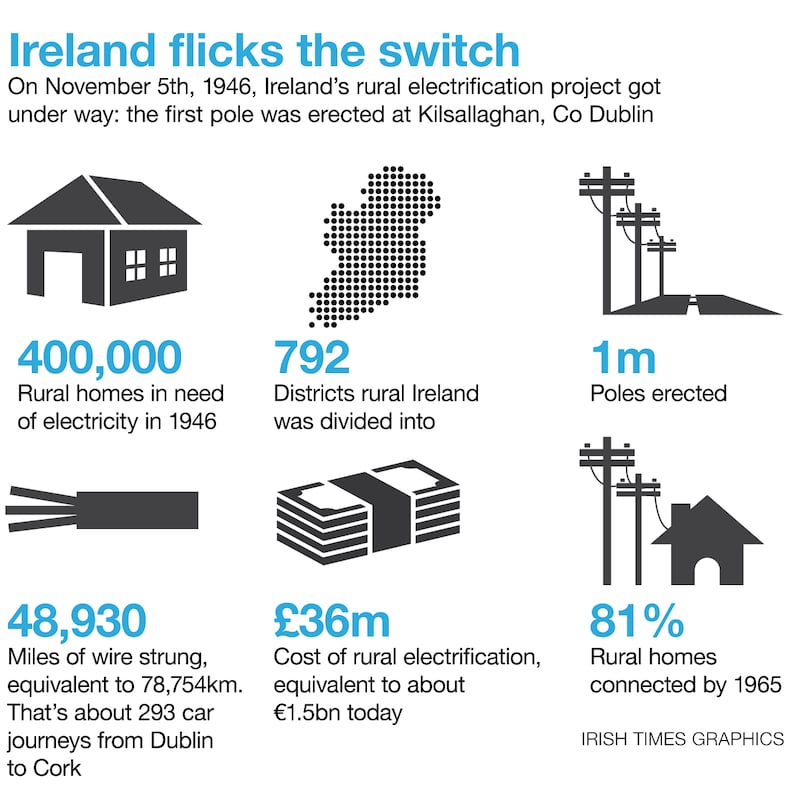Back in the 1950s, John Fitzpatrick, who is now 82, went to work in Moneygall, Co Offaly as an engineering officer for the Rural Electrification Scheme. He was part of the rural EBS "gang" that were based in communities for months at a time.
“The first time I saw Josie, she was cycling to work,” he recalls.
Josie Ryan, now 77, was then teaching in Roscrea. She cycled a round trip of 18 miles a day to work, and when home in the evenings, helped her father with farm work. They had 10 cows, and horses that pulled their plough. "We had no son in our house," she says at the home near Portlaoise when they now live.
0 of 5

They had no electricity either at that time. “We baked bread on the open fire, and bacon and cabbage, and boiled the kettle. We had candles and two double-wicked oil lamps; one for the kitchen and one for the sitting room. There were candles for bedtime, and you had to be very careful with the curtains.”
One of John’s jobs was to negotiate with farmers about poles going in over their land. “They were worried that electricity would be dangerous to animals and that poles would get in the way of ploughs.”
"We all knew they were the ESB gang," Josie says.
“I’d always be making a beeline for the bit of road that Josie’d be cycling home on, just to have a look at her,” says John.
The cyclist and the EBS man finally met at a dance in a hall organised by the Legion of Mary. Josie was doing the tea. He asked her for a dance. “We hadn’t danced 10 yards when I asked her for a date. I was home that weekend and I bought back my best suit, of charcoal grey.”
John and Josie have now been married for 55 years. “When I was getting married, the priest said he hoped I’d have at least 10 children. I had 11,” she says.
Getting connected
At Ballivor in Co Meath, Maureen McGearty still lives in the same house on Main Street that she grew up in. She was seven when her father died in 1951, and was the youngest of eight. "The pension died with Daddy," she says now. "So there wasn't much money."
At the time, the area was being canvassed by the ESB to see which households wanted to be connected. “The local priest was the best worker for the ESB they ever had. He went to every house, and was most enthusiastic about the electricity coming. The priest thought we should get electricity after Daddy died, but how were we to pay for it?”
Her older brother, Patsy, was then 20, and working for Bord na Móna. “He said he’d pay to get connected, and he’d wire the house himself. He was a smart fellow. He went and watched someone else who’d wired their house, and then he came and did ours. I helped him. I was up in the attic, pulling wires.
“They had to break a hole in the wall, and I was small enough to go through it and bring the wires into the next section. The floors had to be taken up. It took ages to wire the place, but the light was switched on at the end of 1953.”
She recalls the difference that electricity brought. “You’d have to clean the kitchen again, because you could see all the cobwebs, especially the ones all lit up on the ceiling. My brothers bought some appliances. We had an iron, and a Baby Belling cooker, two copper kettles and a green electric alarm clock. We got a radio, and that made us stay up longer at night, listening to it.”
At Christmas in 1953, that first Christmas that electricity came to Main Street, Ballivor, the McGearty children came up with an idea to surprise their neighbours.
"The church was next door to us, so we went off and liberated a Christmas tree from a wood, and put it up outside the church gate. We put up fairy lights my brothers had bought in Woolworths in Dublin. They put the lights on the tree, and wired them up to some cable, and then ran it up to my bedroom window, which faced the street. There was only one plug in my bedroom at the time, so I had the fairy lights plugged into it over Christmas. I was the one who turned the lights on and off. The window had to be kept open to let the wire through, and it got quite cold."
The McGeartys lit the Ballivor Christmas tree for more than 20 years in this way. In 2000, Maureen got the house rewired for the first time since her brother had done it, back in 1953. “The man who came to do the job said it had been done perfectly.” She kept the old fuse box out of sentimentality, and now has two; one dating from 1953 and one from the Millennium.
Then There Was Light: Stories Powered by the Rural Electrification Scheme in Ireland, is edited by PJ Cunningham and Joe Kearney, and published by Ballpoint Press
















